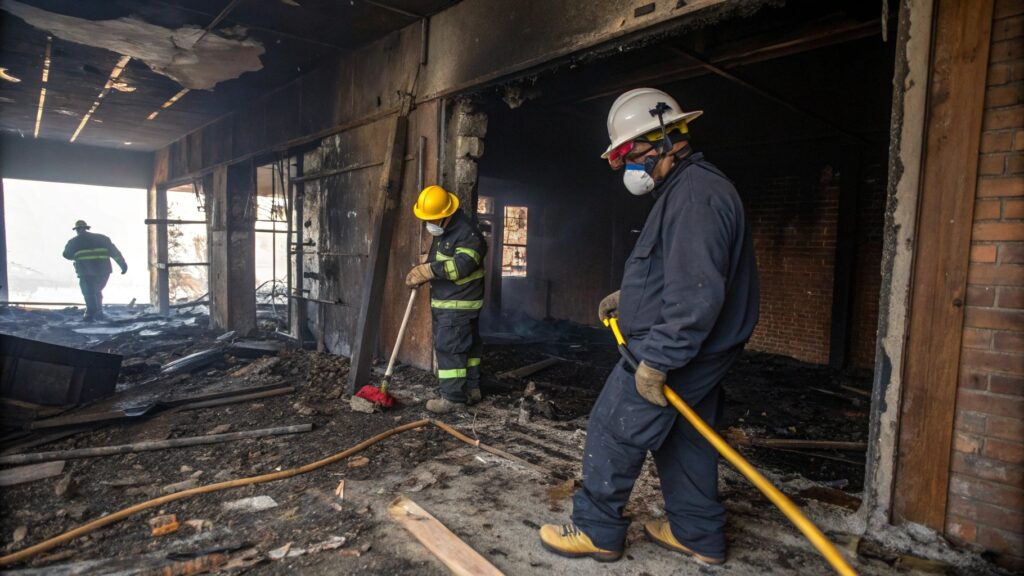Summary
After a fire, moisture from firefighting efforts can quickly lead to mold growth if not properly managed. Fire damage contractors specialize in preventing this by inspecting for hidden moisture, extracting water, drying affected areas, and cleaning soot and smoke residues. They apply antimicrobial treatments and use mold-resistant materials to ensure long-term protection. Certified professionals, such as those accredited by the IICRC, follow strict safety and restoration standards to restore both the structure and indoor air quality. Effective fire damage mold prevention involves rapid response, expert drying, and continuous monitoring to stop mold before it spreads—protecting your home’s integrity and your family’s health while ensuring the property remains safe and mold-free after restoration.
–
Introduction
A fire can devastate a home in more ways than visible damage. While flames and smoke leave behind destruction, the water used to extinguish the fire often causes hidden moisture issues. Left untreated, that moisture becomes the perfect breeding ground for mold posing serious health and structural risks even after restoration seems complete. That’s why homeowners rely on fire damage contractors, professionals trained not only to repair fire damage but also to detect and prevent mold before it spreads. Their combination of technical skill, moisture control strategies, and sanitation expertise ensures your property is safe, clean, and mold-free long after the fire is gone.
Understanding the Link Between Fire and Mold Growth
After a fire, firefighting efforts typically saturate the property with water. The resulting dampness, combined with high humidity and poor ventilation, creates ideal conditions for mold growth. Within just 24 to 48 hours, mold spores can begin developing on walls, ceilings, and floors especially in hidden areas like insulation, HVAC ducts, and under flooring.
Smoke and soot residue can worsen the problem. These byproducts cling to surfaces, trapping moisture and organic debris that feed mold. That’s why mold prevention isn’t a separate process from fire restoration—it’s a critical component of the overall recovery plan.
Step-by-Step Mold Prevention Strategies After Fire Restoration
Step 1: Detailed Inspection and Moisture Assessment
The first step is a comprehensive inspection. Professional contractors use specialized tools like hygrometers, infrared cameras, and moisture meters to locate hidden damp areas that could lead to future mold growth. This process ensures that no wall cavity, floorboard, or duct system remains unchecked.
Step 2: Water Extraction and Rapid Drying
Once the affected areas are identified, water extraction begins. Contractors use industrial-grade pumps and vacuums to remove standing water, followed by high-velocity air movers and dehumidifiers to dry materials completely. Constant humidity monitoring guarantees that no residual moisture is left behind. Proper drying also prevents secondary damage such as wood warping or metal corrosion.
Step 3: Smoke and Soot Removal
After drying, technicians address soot and smoke contamination. Soot particles can trap moisture, making it easier for mold to grow. Professionals use HEPA vacuums, dry sponges, and chemical cleaners to remove residues safely without spreading spores. This step is crucial for restoring indoor air quality and eliminating lingering odors.
Step 4: Antimicrobial Treatment and Sanitization
With moisture under control, antimicrobial treatments are applied to prevent mold regrowth. These EPA-approved solutions kill existing mold spores on contact and form a protective barrier on cleaned surfaces. Reputable fire damage contractors adhere to IICRC standards the recognized industry benchmark for safe and effective restoration practices.
Step 5: Structural Repairs and Continuous Monitoring
In the final stage, contractors replace fire- or water-damaged materials with mold-resistant drywall, insulation, or flooring. They often conduct follow-up inspections using moisture sensors to verify that the structure remains dry over time. This ongoing monitoring gives property owners peace of mind that the mold issue won’t return.
The Role of Professional Expertise in Mold Prevention
Attempting DIY cleanup after a fire might seem cost-effective, but without specialized equipment and training, homeowners can easily overlook hidden moisture pockets. Professional contractors, on the other hand, are certified to handle complex restoration, moisture management, and microbial remediation processes that meet building safety codes.
Their expertise ensures the property is not just visibly clean but also structurally safe and hygienic. They document every step for insurance purposes, ensuring accountability and transparency throughout the restoration.
For dependable and high-quality results, hire a contractor certified by the Institute of Inspection Cleaning and Restoration Certification (IICRC), a globally respected organization that establishes the leading standards for fire, water, and mold remediation services.
Key Takeaways on Preventing Mold After Fire Damage
The connection between fire damage and mold is often underestimated, but understanding it is key to a safe recovery. When handled promptly, professional restoration prevents small water-related issues from turning into large, costly mold infestations. Effective fire damage mold prevention depends on fast response, complete drying, antimicrobial treatment, and continuous inspection. Partnering with certified fire damage contractors ensures these crucial steps are completed to the highest standards protecting your home, your health, and your investment for years to come.
FAQs
Q1. How quickly can mold grow after a fire?
A. Mold can begin to develop within 24 to 48 hours if moisture remains trapped in structural materials or humidity levels aren’t properly managed.
Q2. Can homeowners handle mold prevention themselves after a fire?
A. DIY cleaning may address surface issues but can’t eliminate hidden moisture. Only professional contractors have the tools and expertise to prevent mold effectively and safely.
Q3. What certifications should I look for when hiring a fire damage contractor?
A. Ensure they hold IICRC certification and experience in both fire and water damage restoration. This guarantees proper mold prevention methods and compliance with safety standards.

